Joe Bok and His H-1 Racer
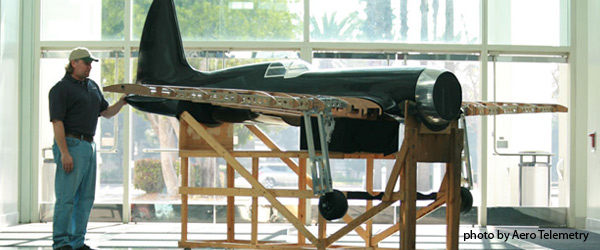
Written by Rachelle Haughn ModelAviation.com online exclusive photos As featured on page 50 in the November 2011 issue.
“IT REMINDED ME of the last time I put my football helmet on.
“You might get a bloody nose or punched in the face, but you’re going to go out there and do the whole football thing. Sometimes you win and sometimes you lose, and that’s the whole thing with life and taking that whole experience with you.”
And what an experience he’s had.
Joe Bok, aerospace engineer and owner of Aero Telemetry, formerly played football for the University of Southern California. He said anticipating the final flight of his Spruce Goose for movie cameras was much like the last time he played college football.
Joe and his crew built scale versions of Howard Hughes’ H-4 Hercules (Spruce Goose), XF-11, and H-1 Racer for the Academy Award-winning 2004 movie, The Aviator.
Joe, 47, said he sometimes looks back and can’t believe that he had the experience of being on the movie set and seeing his Scale models fly. That work put him on the map and Hollywood, the U.S. Government, and NASA have been knocking at his door since the movie premiered.
“That was a challenge to me as an aerospace engineer, a degreed aerospace engineer. That challenged us, pushed us as far as we could go. These are full-scale airplanes that just so happen to be unmanned at this point. From an aerospace engineering standpoint, that was the most challenging. Thank God, it was the most satisfying thing I think I’ve ever done.
“You know as a business owner, being able to get through that financial challenge … on a personal level, just being able to manage a crew like that. Seeing the team come together, and really be able to perform under pressure in an area where we’ve never been. Sometimes you look back on it, the guys that were involved in it early on, and they’re like ‘we can’t believe we did that.’”
Joe, an AMA member, sat down for an interview during the AMA’s 75th anniversary celebration in July at the International Aeromodeling Center in Muncie, Indiana.
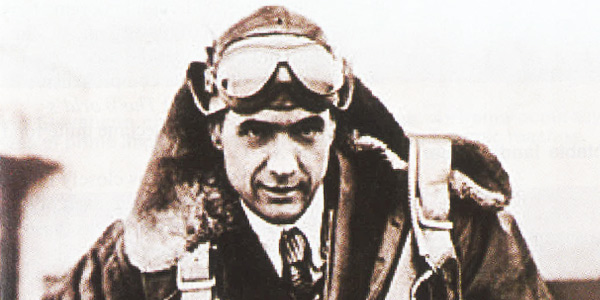
Howard Hughes in the cockpit of his world-record setting H-1B. Photo courtesy of Miramax Film Corp., Aero Telemetry, and Joe Bok.
The Aviator is about Howard Hughes’ life from the mid-1920s through the 1940s. Howard Hughes was a movie producer, business owner, and the inventor of ground-breaking airplanes.
The movie’s director, Martin Scorsese, had planned to use computer-generated imagery (CGI) to create all of the flight sequences for the movie, Joe said. However, after seeing tests of Joe’s 1/4-scale H-1 Racer on a motion-control rig, along with some forced perspective shots, the director changed his mind. Forced perspective is technique that creates an optical illusion. In this case, the actors were placed in front of and behind the model airplane.
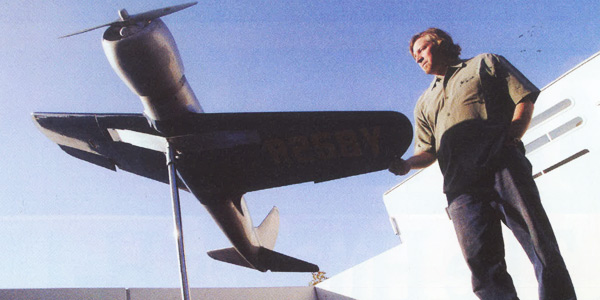
Joe Bock with his 1/4 scale H-1B. It was used as a motion-control example to convince Martin Scorsees to using flying models. Photo courtesy of Eugene Garcia.
About two months later, movie officials contacted Joe and asked him to submit a bid to build scale versions of the XF-11 and Spruce Goose. Joe’s bid was selected.
Another man, Jim Wright, had built a replica of the H-1 Racer that would be used in the movie. However, he was killed when his H-1 Racer crashed on August 4, 2003. After the crash, movie producers contacted Joe and asked if he could also build a 1/2-scale version of the H-1 Racer on a short deadline. The Los Angeles resident described the circumstances.
“I didn’t say yes right away. We had to think about it because I had a full shop of guys running on the XF-11 and I just didn’t know if we had the resources, time or personnel to do it. The other thing was they wanted to shoot that in three weeks. The way it works in the film business is that if it’s in the script and it’s feasible, they’ll do it. Special effects (are) always like second place to the first-unit work. But what they told us specifically was if it couldn’t be done then they’d just write it out of the script and they’d do something else.
“It took a tremendous effort by 35 people we had working on that project in my shop. Thirty-five people, three shifts for three months, nonstop, and the total of time that those shots were in the film was 30, maybe 45 seconds total.
“You’re under so much pressure. It’s like being under fire. The way that those people were at us, telling us that they would sue us if we were late or [if] there were any problems. You could not be late. And the planes had to fly, so they had to work.
“There was none of this ‘oh, sorry, the dog ate my homework’ kind of thing. They’d sue [you]. They’d say we’re either going to sue you or were gonna cancel the contract, or we’ll write it out of the script.
“So there’s just the threat, pressure, and the risk on the company and on me personally at that time, as far as a business owner. And my reputation as an engineer was all on the line. If any of those planes would have crashed, for any reason at all, that’s what you would remember that whole thing by.”
To build the H-1 Racer, Joe, CEO of Aero Telemetry, and his crew studied photographs and drawings of the original aircraft, which is on display in the Smithsonian National Air and Space Museum.
Although it had the shortest deadline, the H-1 Racer was the first airplane filmed for the movie. Joe had three months to build the Spruce Goose and the XF-11.
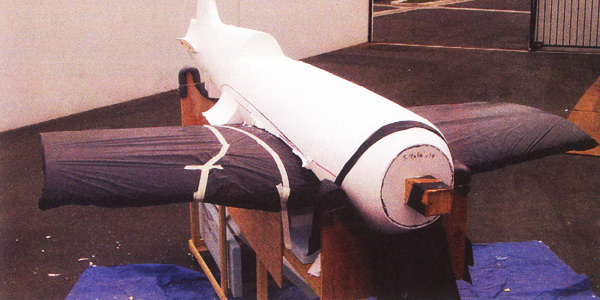
The H-1B designed and built from old Hughes drawings begins to take shape. Photo courtesy of Miramax Film Corp., Aero Telemetry, and Joe Bok.
The Aero Telemetry crew also built static models of World War I airplanes, such as a 1/5-scale Fokker D. VII, Spads, a Sikorsky S-38, and a bomber. These models were used for the Hell’s Angels movie scenes.
The Spruce Goose was the last model filmed for the movie. Joe reflected on the last day of filming. He said knowing that filming was wrapping up was bittersweet.
“I remember that toward the last flight of the Spruce Goose I was standing there watching filming. Ian Stevenson, who was our painter, he was putting the last coat of paint on the Spruce Goose. It was 1 or 2 in the morning before the last flight and it dawned on me the next morning that that was the end of it. The next day we were going to come in and nobody would be in the shop. Everybody would be going back to what they were doing.”

Joe Bock (L) tuck the H-1 racer back into its trailer after a successful film flight. Photo courtesy of Miramax Film Corp., Aero Telemetry, and Joe Bok.
After filming wrapped Joe got a nice surprise when one of the movie’s trailers premiered.
“The real honor about the whole thing is the trailers for the film [were shown] at the Academy Awards and Golden Globes. Think about it, you only have 30 seconds to show—it’s a 41/2 hour film—you’re going to show 30 seconds of footage. All three of our airplanes, our airplanes flying, were in those 30-second trailers. So that’s, to me, that’s the highest honor and compliment you can get as a builder and designer.
“Every one of those planes came home. Every one of them landed every time. They got their shots. I know it’s sort of a movie is way bigger than what we did, but it was a real accomplishment in terms of what we did. With the way that regulations are right now with the FAA, we couldn’t have done it again. Not like that, anyway. That scale.”
After the last bit of footage was shot, the movie studio was left with large, unmanned airplanes. Joe said the static models were auctioned off by the movie company. Since the larger aircraft were considered medium-endurance tactical UAVs (Unmanned Air Vehicles), and could be dangerous in the wrong hands, they had to be disassembled.
The hardware, landing gear, controls, and arms, were removed. The H-1 Racer was donated to a museum, but the other two models had to be cut up. Joe said that after all of the work he had put into the models, he couldn’t bear to see them destroyed.
“I couldn’t; I didn’t do it. I actually pointed to the reciprocating saw, told one of the guys—one of our best guys—to do it and I left and went to lunch. I didn’t want to be there for that.”
Since filming ended, Joe and his employees have kept busy with the flood of new business that has come their way.
“I think The Aviator put us on the map in terms of large-scale airplanes that had to perform. They had to be built in an extraordinarily short amount of time. They had to work. These weren’t on a stick and they weren’t, you know, like the motion control [models] in Hollywood.
“Our ability to be able to make airplanes quickly and safely and have them work, it’s something that we’ve gotten better at since The Aviator. When the press came out, we picked up a little bit of UAV business and air frame fabrication for companies.”
When building the aircraft for the movie, Joe discovered there was no landing gear available for such large unmanned airplanes. So, he and his team built their own. After the movie was released, this invention meant more business for the company.
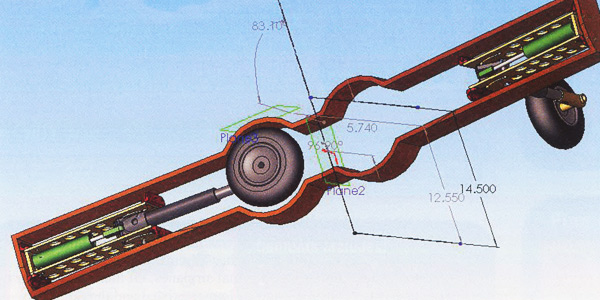
Aero Telemetry designed major H-1 structures - such as the retractable landing gear system. Photo courtesy of Miramax Film Corp., Aero Telemetry, and Joe Bok.
“We picked up a ton of business doing (retractable) landing gear, hydraulic landing gear systems for different commercial aerospace and military drones. It’s kind of dirty work but it’s actually really pretty satisfying.
“It’s real easy to build a fuselage and throw somebody else’s engine on there. Nobody makes landing gear systems for these planes. No one, not in this size. You’d better have a guy who knows how to run a CAD, [do] solid work on the computer. You’d better have a machinist who knows how to hand-crank a part and a CNC machine; somebody who knows how to work a lathe; and you need an installation guy who knows how to put all that stuff together and make it work. It’s a complicated process.”
The company also continues to build electronics for UAVs, as well as equipment for the military. This equipment is used by men and women serving on the front lines in Afghanistan and Iraq, he said.
NASA also is an Aero Telemetry customer. Joe’s company builds electronic systems that support NASA’s meteorological equipment.
“These projects for Hollywood come around like every like three or four years,” he said.
Movie officials have considered Joe and his company for two other movie projects since The Aviator, and an upcoming movie project is looking promising.
Joe said he was contacted by director Michael Bay for the movie, The Island, but declined to submit a bid. Bay wanted Joe to build a helicopter that would fly very close to the actors. Joe said he felt the large aircraft would be too dangerous.
He also was considered for a Clint Eastwood film called Flags of Our Fathers. However, film officials decided to use CGI for that movie.
Joe seemed quite excited about a potential new movie project.
“Paramount Pictures just picked up a Warren Beatty film and we were contacted. It’s funny. The night that we finished this plane, this was Friday, the week before the show, we just finished it and I got a phone call from a guy asking questions about and saying they had a script for Warren Beatty and they needed an XF-11.” Joe and his crew built a scale version of the H-1 Racer for the AMA’s 75th anniversary celebration.
Joe said he was told that filming for the movie will begin this fall. He said the movie is unnamed and expected to have an all-star cast.
“I don’t know that we’re going to be involved in it, but I hope we are.”
Joe said he plans to build a scale version of the XF-11, even if it isn’t for a movie. He was asked by the AMA to build a half-scale H-1 Racer, which made its maiden flight during the 75th anniversary event. In all, the airplane was flown seven times during the event. Joe said he wants to use new technology he and his staff used for this version of the H-1 Racer for the XF-11.
“(The) AMA approached me a year ago and said can you build us something like you did for The Aviator. And we talked about the three big models here: the Spruce Goose, the XF-11, and this one,” he said, while gesturing to the H-1 Racer. “Spruce Goose in Muncie, Indiana, would be kind of illegal. The XF-11 was a very challenging plane, and to be honest, there’s no way we could build it under 125 pounds.” (The AMA currently has a weight limit of 125 pounds for propeller-driven airplanes.)
“So, we said the H-1 would be a great plane to build. Everybody in the shop’s passionate about the airplane.”
When Joe and his crew first built the half-scale H-1 for the AMA, it weighed 225 pounds. They learned in January of this year that the weight had to be reduced by at least 100 pounds. For two months, the Aero Telemetry crew tried to think of ways to dramatically cut down the weight. They finally came up with a solution.
“The primary weight-saving technique was the use of carbon fiber and resin infusion technology. It’s a technique by which you lay up the carbon fiber and it allows for the least amount of resin to be absorbed by the fabric. So you keep the structure as light as possible.
“Some of the stuff that we’ve done on this plane wasn’t available to us in 2003.”
After building the plane, Joe had to figure out who would fly it. He learned about a week before the AMA’s event began that the pilot he had chosen couldn’t make it. He contacted the AMA and someone suggested Competitions Department Director Greg Hahn. Joe said he didn’t know Greg, but had heard of him. Greg has been in the hobby industry for 20 years and is known for flying large, heavy, and complex models.
Joe said he was impressed with how Greg handled the H-1 during the 75th anniversary event.
“I’m really, really, really happy I made his acquaintance. And I tell you what, if we do any more flying with this plane or anything else—if he can get on an airplane and come out to California—he’s the man.”
The airplane was a big hit during the 75th anniversary airshows. Many people stopped and looked at the big aircraft when it wasn’t in the air and asked Joe and his crew questions. He said some fliers at other sites thought it was a full-scale airplane.
The XF-11 isn’t the only scale model that Joe would like to build.
He said he would love to build a Lockheed Constellation. The full-scale airplane was built by TWA, but Howard Hughes had a hand in its design. Joe has an engine from a full-scale Lockheed Constellation in his shop, which he fires up once in a while.
When he has spare time, he likes to fly scale warbirds and electric-powered model airplanes. He joined the AMA in the early 1990s.
He said joining the AMA would be a great first step for someone interested in building aircraft for movies.
“Come out here and fly some airplanes,” he said.
Sources:
Aero Telemetry
www.aerotelemetry.com
Read more through our sister publication, The Park Pilot.
You can also build the Hughes H-1 Racer yourself!










Add new comment